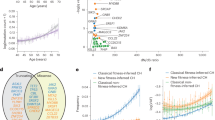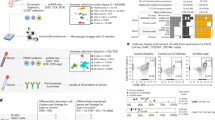Abstract
SHIP-1 has an important role in controlling immune cell function through its ability to downmodulate PI3K signaling pathways that regulate cell survival and responses to stimulation. Mice deficient in SHIP-1 display several chronic inflammatory phenotypes including antibody-mediated autoimmune disease, Crohn’s disease-like ileitis and a lung disease reminiscent of chronic obstructive pulmonary disease. The ileum and lungs of SHIP-1-deficient mice are infiltrated at an early age with abundant myeloid cells and the mice have a limited lifespan primarily thought to be due to the consolidation of lungs with spontaneously activated macrophages. To determine whether the myeloid compartment is the key initiator of inflammatory disease in SHIP-1-deficient mice, we examined two independent strains of mice harboring myeloid-restricted deletion of SHIP-1. Contrary to expectations, conditional deletion of SHIP-1 in myeloid cells did not result in consolidating pneumonia or segmental ileitis typical of germline SHIP-1 deficiency. In addition, other myeloid cell abnormalities characteristic of germline loss of SHIP-1, including flagrant splenomegaly and enhanced myelopoiesis, were absent in mice lacking SHIP-1 in myeloid cells. This study indicates that the spontaneous inflammatory disease characteristic of germline SHIP-1 deficiency is not initiated solely by LysM-positive myeloid cells but requires the simultaneous loss of SHIP-1 in other hematolymphoid lineages.
This is a preview of subscription content, access via your institution
Access options
Subscribe to this journal
Receive 6 digital issues and online access to articles
$119.00 per year
only $19.83 per issue
Buy this article
- Purchase on Springer Link
- Instant access to full article PDF
Prices may be subject to local taxes which are calculated during checkout





Similar content being viewed by others
References
Fruman DA, Bismuth G . Fine tuning the immune response with PI3K. Immunol Rev 2009; 228: 253–272.
Hirsch E, Ciraolo E, Ghigo A, Costa C . Taming the PI3K team to hold inflammation and cancer at bay. Pharmacol Ther 2008; 118: 192–205.
Kerr WG . Inhibitor and activator: dual functions for SHIP in immunity and cancer. Ann NY Acad Sci 2011; 1217: 1–17.
Tiwari S, Choi HP, Matsuzawa T, Pypaert M, MacMicking JD . Targeting of the GTPase Irgm1 to the phagosomal membrane via PtdIns(3,4)P(2) and PtdIns(3,4,5)P(3) promotes immunity to mycobacteria. Nat Immunol 2009; 10: 907–917.
Brooks R, Fuhler GM, Iyer S, Smith MJ, Park MY, Paraiso KH et al. SHIP1 inhibition increases immunoregulatory capacity and triggers apoptosis of hematopoietic cancer cells. J Immunol 2010; 184: 3582–3589.
Helgason CD, Damen JE, Rosten P, Grewal R, Sorensen P, Chappel SM et al. Targeted disruption of SHIP leads to hemopoietic perturbations, lung pathology, and a shortened life span. Genes Dev 1998; 12: 1610–1620.
Liu Q, Sasaki T, Kozieradzki I, Wakeham A, Itie A, Dumont DJ et al. SHIP is a negative regulator of growth factor receptor-mediated PKB/Akt activation and myeloid cell survival. Genes Dev 1999; 13: 786–791.
Ghansah T, Paraiso KH, Highfill S, Desponts C, May S, McIntosh JK et al. Expansion of myeloid suppressor cells in SHIP-deficient mice represses allogeneic T cell responses. J Immunol 2004; 173: 7324–7330.
Harder KW, Quilici C, Naik E, Inglese M, Kountouri N, Turner A et al. Perturbed myelo/erythropoiesis in Lyn -deficient mice is similar to that in mice lacking the inhibitory phosphatases SHP-1 and SHIP-1. Blood 2004; 104: 3901–3910.
Maxwell MJ, Duan M, Armes JE, Anderson GP, Tarlinton DM, Hibbs ML . Genetic segregation of inflammatory lung disease and autoimmune disease severity in SHIP-1−/− mice. J Immunol 2011; 186: 7164–7175.
Rauh MJ, Ho V, Pereira C, Sham A, Sly LM, Lam V et al. SHIP represses the generation of alternatively activated macrophages. Immunity 2005; 23: 361–374.
Mills CD, Kincaid K, Alt JM, Heilman MJ, Hill AM . M-1/M-2 macrophages and the Th1/Th2 paradigm. J Immunol 2000; 164: 6166–6173.
Duan M, Li WC, Vlahos R, Maxwell MJ, Anderson GP, Hibbs ML . Distinct macrophage subpopulations characterize acute infection and chronic inflammatory lung disease. J Immunol 2012; 189: 946–955.
Kerr WG, Park MY, Maubert M, Engelman RW . SHIP deficiency causes Crohn's disease-like ileitis. Gut 2011; 60: 177–188.
McLarren KW, Cole AE, Weisser SB, Voglmaier NS, Conlin VS, Jacobson K et al. SHIP-deficient mice develop spontaneous intestinal inflammation and arginase-dependent fibrosis. Am J Pathol 2011; 179: 180–188.
Karlsson MC, Guinamard R, Bolland S, Sankala M, Steinman RM, Ravetch JV . Macrophages control the retention and trafficking of B lymphocytes in the splenic marginal zone. J Exp Med 2003; 198: 333–340.
Collazo MM, Paraiso KH, Park MY, Hazen AL, Kerr WG . Lineage extrinsic and intrinsic control of immunoregulatory cell numbers by SHIP. Eur J Immunol 2012; 42: 1785–1795.
Wang JW, Howson JM, Ghansah T, Desponts C, Ninos JM, May SL et al. Influence of SHIP on the NK repertoire and allogeneic bone marrow transplantation. Science 2002; 295: 2094–2097.
Hadidi S, Antignano F, Hughes MR, Wang SK, Snyder K, Sammis GM et al. Myeloid cell-specific expression of Ship1 regulates IL-12 production and immunity to helminth infection. Mucosal Immunol 2012; 5: 535–543.
Clausen BE, Burkhardt C, Reith W, Renkawitz R, Forster I . Conditional gene targeting in macrophages and granulocytes using LysMcre mice. Transgenic Res 1999; 8: 265–277.
Nguyen NY, Maxwell MJ, Ooms LM, Davies EM, Hilton AA, Collinge JE et al. An ENU-induced mouse mutant of SHIP1 reveals a critical role of the stem cell isoform for suppression of macrophage activation. Blood 2011; 117: 5362–5371.
Oliver AM, Martin F, Gartland GL, Carter RH, Kearney JF . Marginal zone B cells exhibit unique activation, proliferative and immunoglobulin secretory responses. Eur J Immunol 1997; 27: 2366–2374.
Liu Q, Oliveira-Dos-Santos AJ, Mariathasan S, Bouchard D, Jones J, Sarao R et al. The inositol polyphosphate 5-phosphatase SHIP is a crucial negative regulator of B cell antigen receptor signaling. J Exp Med 1998; 188: 1333–1342.
Helgason CD, Kalberer CP, Damen JE, Chappel SM, Pineault N, Krystal G et al. A dual role for Src homology 2 domain-containing inositol-5-phosphatase (SHIP) in immunity: aberrant development and enhanced function of B lymphocytes in SHIP −/− mice. J Exp Med 2000; 191: 781–794.
Takeshita S, Namba N, Zhao JJ, Jiang Y, Genant HK, Silva MJ et al. SHIP-deficient mice are severely osteoporotic due to increased numbers of hyper-resorptive osteoclasts. Nat Med 2002; 8: 943–949.
Huber M, Helgason CD, Damen JE, Liu L, Humphries RK, Krystal G . The src homology 2-containing inositol phosphatase (SHIP) is the gatekeeper of mast cell degranulation. Proc Natl Acad Sci USA 1998; 95: 11330–11335.
Maxwell MJ, Yuan Y, Anderson KE, Hibbs ML, Salem HH, Jackson SP . SHIP1 and Lyn kinase negatively regulate integrin αIIbβ3 signaling in platelets. J Biol Chem 2004; 279: 32196–32204.
Wahle JA, Paraiso KH, Costello AL, Goll EL, Sentman CL, Kerr WG . Cutting edge: dominance by an MHC-independent inhibitory receptor compromises NK killing of complex targets. J Immunol 2006; 176: 7165–7169.
Oh SY, Zheng T, Bailey ML, Barber DL, Schroeder JT, Kim YK et al. Src homology 2 domain-containing inositol 5-phosphatase 1 deficiency leads to a spontaneous allergic inflammation in the murine lung. J Allergy Clin Immunol 2007; 119: 123–131.
Baran CP, Tridandapani S, Helgason CD, Humphries RK, Krystal G, Marsh CB . The inositol 5'-phosphatase SHIP-1 and the Src kinase Lyn negatively regulate macrophage colony-stimulating factor-induced Akt activity. J Biol Chem 2003; 278: 38628–38636.
Sly LM, Rauh MJ, Kalesnikoff J, Song CH, Krystal G . LPS-induced upregulation of SHIP is essential for endotoxin tolerance. Immunity 2004; 21: 227–239.
Kuroda E, Ho V, Ruschmann J, Antignano F, Hamilton M, Rauh MJ et al. SHIP represses the generation of IL-3-induced M2 macrophages by inhibiting IL-4 production from basophils. J Immunol 2009; 183: 3652–3660.
Smith SM, Lee DK, Lacy J, Coleman DL . Rat tracheal epithelial cells produce granulocyte/macrophage colony-stimulating factor. Am J Respir Cell Mol Biol 1990; 2: 59–68.
Bilyk N, Holt PG . Inhibition of the immunosuppressive activity of resident pulmonary alveolar macrophages by granulocyte/macrophage colony-stimulating factor. J Exp Med 1993; 177: 1773–1777.
Hawley RG, Fong AZ, Burns BF, Hawley TS . Transplantable myeloproliferative disease induced in mice by an interleukin 6 retrovirus. J Exp Med 1992; 176: 1149–1163.
Maeda K, Baba Y, Nagai Y, Miyazaki K, Malykhin A, Nakamura K et al. IL-6 blocks a discrete early step in lymphopoiesis. Blood 2005; 106: 879–885.
Ikebuchi K, Wong GG, Clark SC, Ihle JN, Hirai Y, Ogawa M . Interleukin 6 enhancement of interleukin 3-dependent proliferation of multipotential hemopoietic progenitors. Proc Natl Acad Sci USA 1987; 84: 9035–9039.
Tsuji K, Lyman SD, Sudo T, Clark SC, Ogawa M . Enhancement of murine hematopoiesis by synergistic interactions between steel factor (ligand for c-kit), interleukin-11, and other early acting factors in culture. Blood 1992; 79: 2855–2860.
Nakamura K, Kouro T, Kincade PW, Malykhin A, Maeda K, Coggeshall KM . Src homology 2-containing 5-inositol phosphatase (SHIP) suppresses an early stage of lymphoid cell development through elevated interleukin-6 production by myeloid cells in bone marrow. J Exp Med 2004; 199: 243–254.
Hazen AL, Smith MJ, Desponts C, Winter O, Moser K, Kerr WG . SHIP is required for a functional hematopoietic stem cell niche. Blood 2009; 113: 2924–2933.
Hoggatt J, Pelus LM . Many mechanisms mediating mobilization: an alliterative review. Curr Opin Hematol 2011; 18: 231–238.
Desponts C, Hazen AL, Paraiso KH, Kerr WG . SHIP deficiency enhances HSC proliferation and survival but compromises homing and repopulation. Blood 2006; 107: 4338–4345.
Tu Z, Ninos JM, Ma Z, Wang JW, Lemos MP, Desponts C et al. Embryonic and hematopoietic stem cells express a novel SH2-containing inositol 5'-phosphatase isoform that partners with the Grb2 adapter protein. Blood 2001; 98: 2028–2038.
Tarasenko T, Kole HK, Chi AW, Mentink-Kane MM, Wynn TA, Bolland S . T cell-specific deletion of the inositol phosphatase SHIP reveals its role in regulating Th1/Th2 and cytotoxic responses. Proc Natl Acad Sci USA 2007; 104: 11382–11387.
Anderson BE, McNiff JM, Matte C, Athanasiadis I, Shlomchik WD, Shlomchik MJ . Recipient CD4+ T cells that survive irradiation regulate chronic graft-versus-host disease. Blood 2004; 104: 1565–1573.
Acknowledgements
This work was supported by grants from the NH&MRC of Australia and USA NIH (RO1 HL72523, R01 HL085580, R01 HL107127) and the Paige Arnold Butterfly Run to WGK. MJM and MLH were supported by NH&MRC fellowships. WGK is the Murphy Family Professor of Children’s Oncology Research, an Empire Scholar of the State University of NY and a Senior Scholar of the Crohn’s and Colitis Foundation of America. We acknowledge Jeffrey Ravetch for SHIPFLOX mice, Cathy Quilici, Melissa Inglese and Ryan Farid for technical assistance, Monash Micro Imaging for imaging assistance, Bonnie Toms and Christy Youngs for genotyping of LysCreSHIPflox/flox mice and animal facility staff.
Author information
Authors and Affiliations
Corresponding authors
Ethics declarations
Competing interests
WGK is an inventor of issued and pending patents pertaining to detection or modulation of SHIP-1 expression in various diseases, including inflammatory diseases. The remaining authors declare no conflict of interest.
Rights and permissions
About this article
Cite this article
Maxwell, M., Srivastava, N., Park, MY. et al. SHIP-1 deficiency in the myeloid compartment is insufficient to induce myeloid expansion or chronic inflammation. Genes Immun 15, 233–240 (2014). https://doi.org/10.1038/gene.2014.9
Received:
Revised:
Accepted:
Published:
Issue Date:
DOI: https://doi.org/10.1038/gene.2014.9
This article is cited by
-
Selective deletion of SHIP-1 in hematopoietic cells in mice leads to severe lung inflammation involving ILC2 cells
Scientific Reports (2021)
-
Lyn prevents aberrant inflammatory responses to Pseudomonas infection in mammalian systems by repressing a SHIP-1-associated signaling cluster
Signal Transduction and Targeted Therapy (2016)



